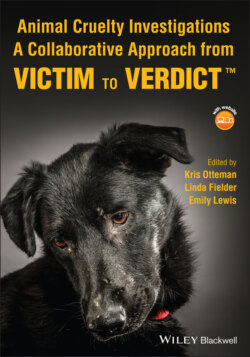Читать книгу Animal Cruelty Investigations - Группа авторов - Страница 126
3.2 Environment
ОглавлениеMany investigations begin with the report of an animal living in an inadequate environment. Animals confined to a pen, a crate, a stall, or tethered by a chain may suffer illness and injury as a result of their inability to get away from their feces, or standing water, or other unsafe or unsanitary conditions present in their environment.
An environment marked by excess feces and urine, standing water, or thick mud can cause painful issues, including ulcerated sores on the feet and hocks, infection, which may progress through the skin and into the bone, hoof and skeletal abnormalities, a high incidence of miscarriage and death of neonates, injuries caused by an animal's repeated attempts to escape the environment, gastrointestinal disease, and parasite burden. These are only some of the conditions animals may develop as a result of living in a squalid environment and which contribute to a conclusion that the animals are suffering from criminal animal neglect.
So many aspects of an animal's environment are relevant to a criminal investigation. The environment includes the high and low temperatures an animal is exposed to, access to shelter or shade from the elements, the provision of reasonably clean and dry bedding, and the physical space to shift positions, stand, sit, and lie comfortably, with flooring that does not injure or entrap an animal's feet or limbs.
In the case of a physical abuse or animal fighting investigation an animal's environment will also contain evidence vital to the investigation. Implements used to strike a victim animal, blood spatter, or indicators of a physical altercation or struggle may all be visible in the environment and subject to the keen eye of the investigator. Equipment used to condition animals for fighting or supplies to treat wounds are often discovered hidden or in plain view within the environment of a dog‐ or cockfighter.
The opportunity for evaluating an animal's environment is often time sensitive. You may not be granted access to view the area where an animal is kept or may only see it for a brief time during an initial site visit. Knowing how the environment impacts the health and well‐being of an animal is crucial to ensuring you notice important aspects of the environment in the time you are given. In the case of a search warrant execution, more time may be available for the assessment of the environment. Photo and video recordings preserve the conditions for later review by investigators, veterinarians, prosecutors, defense attorneys, and judge and jury.
When examining an animal's environment be sure to look for and record what is present as well as what is missing. For example, if the enclosure is wet with standing mud and rainwater, but there is no drinking bowl or trough with potable water the animal can access, this must be noted in the record. By specifically indicating that you did not see any water trough or container available to the animal, this overcomes the notion that you may have neglected to notice a water container that was clearly present in the pen or stall.
Generally, when responding to reports of an unacceptable environment, the investigator should assess the following components:
Shelter: Is it safe and appropriate for the species and number of animals? Can they maintain a normal body temperature, and does it provide protection from wind, rain, cold, heat, and standing water?
Confinement (fences, cages, stalls, chains): Does the method of confinement contain hazards or harmful components such as broken wires, rust, damaged floors, or doors? Is the chain so tight as to cause wounds on the animal's neck? Does the size and design of the enclosure allow for the animal to stand, move, rest, and sleep comfortably? Does it restrict their movement and expression of natural behaviors such as cleaning themselves, stretching, eating, and drinking?
Surrounding areas (yard, room, pasture, barn): Are there dry areas where the animal can walk, sit, lie, and eat away from standing water, feces and urine, contaminants and other hazards. Is there mud, downed trees, machinery, vehicles, or other dangers within reach of the animal and on which it could injure itself or become trapped or entangled?
